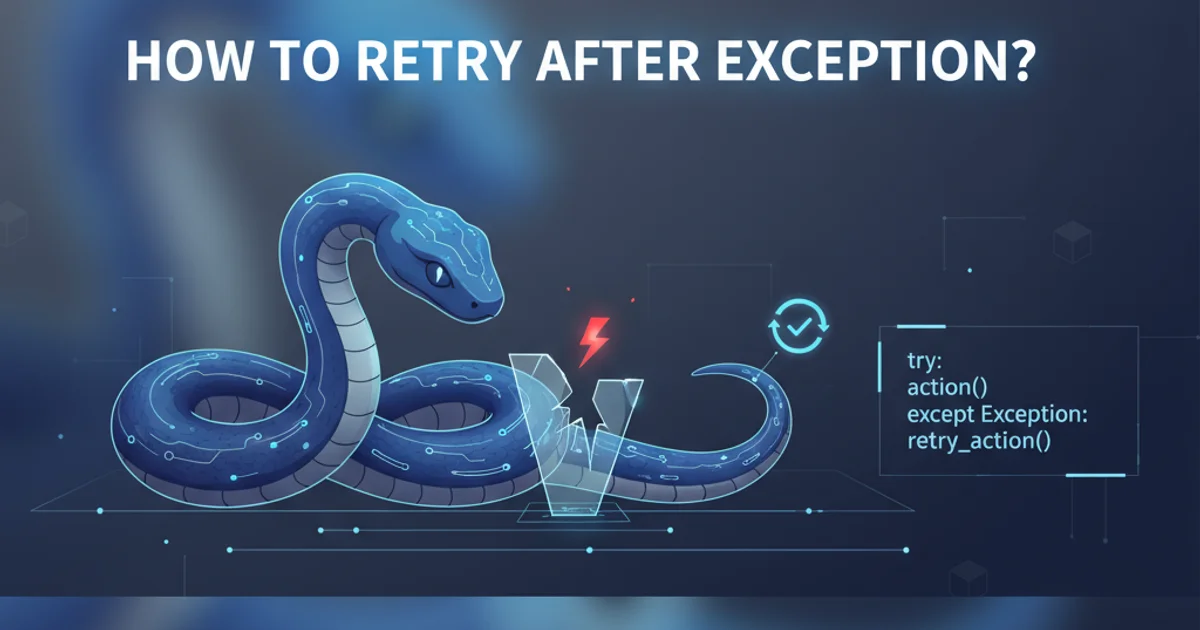How to retry after exception?
Categories:
Robust Error Handling: Retrying Operations After Exceptions in Python

Learn how to implement effective retry mechanisms in Python to handle transient errors and improve the resilience of your applications using try-except blocks and loops.
In software development, especially when dealing with external services, network operations, or resource contention, transient errors are a common occurrence. These are temporary failures that often resolve themselves after a short period. Instead of letting your program crash or fail permanently, implementing a retry mechanism can significantly enhance its robustness and reliability. This article will guide you through various strategies for retrying operations after an exception in Python, leveraging try-except blocks and control flow.
The Basic Retry Loop
The simplest way to retry an operation is to wrap it in a while loop and use a try-except block to catch specific exceptions. If an exception occurs, the loop can continue, optionally after a short delay. This approach is suitable for scenarios where you expect the operation to eventually succeed.
import time
def unreliable_function():
# Simulate an operation that fails sometimes
if time.time() % 5 < 2: # Fails roughly 40% of the time
raise ConnectionError("Simulated network issue")
return "Operation successful!"
max_retries = 5
retries = 0
success = False
while retries < max_retries and not success:
try:
result = unreliable_function()
print(result)
success = True
except ConnectionError as e:
retries += 1
print(f"Attempt {retries} failed: {e}. Retrying in 1 second...")
time.sleep(1)
if not success:
print(f"Failed after {max_retries} attempts.")
A basic retry loop with a fixed number of attempts and a static delay.
Exception can mask unexpected errors and make debugging difficult. For network operations, requests.exceptions.ConnectionError or socket.error are common choices.Implementing Exponential Backoff
A fixed delay between retries can be inefficient. If a service is overloaded, hammering it with retries at a constant interval might worsen the problem. Exponential backoff is a strategy where the delay between retries increases exponentially with each subsequent attempt. This gives the service more time to recover and reduces the load on it. It's a common practice in distributed systems and API interactions.
flowchart TD
A[Start Operation] --> B{Attempt Operation};
B -- Success --> C[End];
B -- Failure --> D{Retry Count < Max Retries?};
D -- Yes --> E[Calculate Exponential Delay];
E --> F[Wait for Delay];
F --> B;
D -- No --> G[Fail Operation];Flowchart illustrating the exponential backoff retry mechanism.
import time
import random
def unreliable_api_call():
# Simulate an API call that fails randomly
if random.random() < 0.7: # Fails 70% of the time
raise TimeoutError("API call timed out")
return "API data received!"
max_retries = 7
base_delay = 0.5 # seconds
retries = 0
success = False
while retries < max_retries and not success:
try:
result = unreliable_api_call()
print(result)
success = True
except TimeoutError as e:
retries += 1
if retries < max_retries:
delay = base_delay * (2 ** (retries - 1)) + random.uniform(0, 0.1) # Add jitter
print(f"Attempt {retries} failed: {e}. Retrying in {delay:.2f} seconds...")
time.sleep(delay)
else:
print(f"Attempt {retries} failed: {e}. Max retries reached.")
if not success:
print(f"Operation ultimately failed after {max_retries} attempts.")
Implementing exponential backoff with jitter for retries.
Using a Decorator for Reusability
For more complex applications, manually writing retry logic for every function can lead to repetitive code. Python decorators provide an elegant way to encapsulate retry logic and apply it to multiple functions without modifying their core implementation. This promotes code reusability and cleaner code.
import time
import random
import functools
def retry(max_attempts=3, delay=1, backoff_factor=2, exceptions=(Exception,)): # Added exceptions parameter
def decorator(func):
@functools.wraps(func)
def wrapper(*args, **kwargs):
attempts = 0
current_delay = delay
while attempts < max_attempts:
try:
return func(*args, **kwargs)
except exceptions as e:
attempts += 1
if attempts == max_attempts:
print(f"Failed after {max_attempts} attempts. Raising exception.")
raise
print(f"Attempt {attempts} failed: {e}. Retrying in {current_delay:.2f} seconds...")
time.sleep(current_delay)
current_delay *= backoff_factor
current_delay += random.uniform(0, 0.1) # Add jitter
return wrapper
return decorator
@retry(max_attempts=5, delay=0.5, backoff_factor=2, exceptions=(ConnectionError, TimeoutError))
def fetch_data_from_service():
if random.random() < 0.8: # Fails 80% of the time
if random.random() < 0.5:
raise ConnectionError("Network connection lost")
else:
raise TimeoutError("Service did not respond in time")
return "Data successfully fetched!"
# Example usage:
try:
print(fetch_data_from_service())
except (ConnectionError, TimeoutError) as e:
print(f"Final failure: {e}")
A reusable retry decorator with exponential backoff and configurable exceptions.
TypeError or ValueError often indicates a programming bug that won't be resolved by retrying. Only retry for transient, recoverable errors.